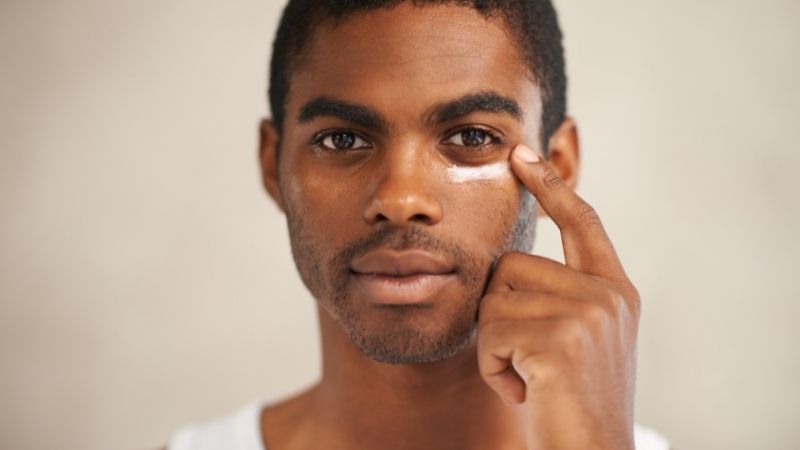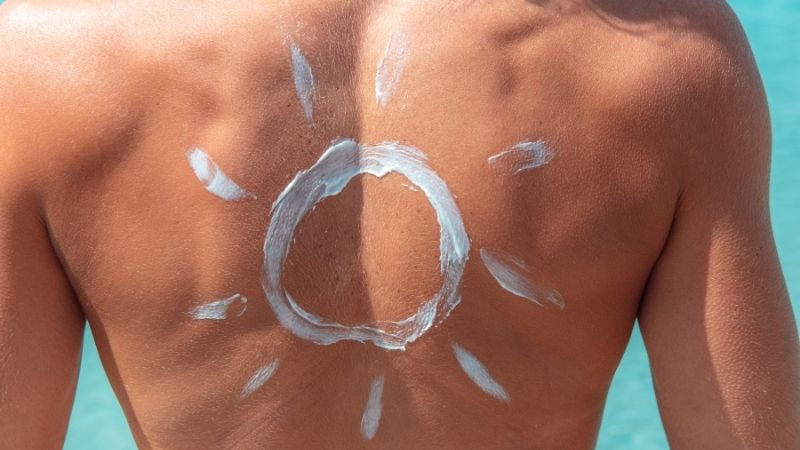Why Men Don’t Wear Sunscreen + Its Impact on Their Skin in Later Years

For many women, applying sunscreen is just as much a part of their daily routine as washing their face or brushing their hair. What about men? They wear sunscreen regularly, too, right? Unfortunately, no. Even though most men know that sunscreen is crucial for preventing skin cancer and premature aging, they just don’t feel like it’s a daily necessity.
It may also surprise you to hear that melanoma – the deadliest form of skin cancer – kills twice as many men every year as women. Men simply aren’t as conscientious about sun exposure as women. In fact, many men don’t wear sunscreen at all… unless they’re shamed into it or they know they’ll be in the sun for a few hours.
Some men like the look of a tan and only apply sunscreen when it’s absolutely necessary to avoid a painful sunburn. But allowing the skin to tan or burn over and over again leads to accumulated damage at the cellular level. It increases the risk of skin cancer later in life and also leads to the signs of premature aging – like sun spots, fine lines, wrinkles, and leathery skin.
Today, we’re going to explore the reasons men don’t wear sunscreen regularly and how to overcome them. We’re also going to explain how accumulated sun damage can impact your skin later in life, even if you’re not seeing the signs right now.
And if you’ve been less than consistent with the sunscreen, we’ll talk about some ways you can minimize existing sun damage. Let’s dive in!

Why don’t men wear sunscreen regularly?
Only about 14% of men apply sunscreen to their face daily. But even worse than that, only about 18% of men apply sunscreen to their face and body when they’re going to be out in the sun for more than an hour.
Women are three times more likely to apply sunscreen before heading outdoors. They’re used to applying makeup and taking care of their skin every day, so it’s only natural that they would be more attentive about sun protection, too.
But why are men so resistant to wearing sunscreen? Well, skincare just isn’t a priority for many men. Skincare products are generally marketed towards women, too. Some men might think wearing sunscreen is at odds with their masculinity.
Or they just don’t think they need it because they believe women’s skin is more sensitive to sunburn and sun damage. Men don’t seem to be as interested in learning about the effects of sun exposure, either, which also plays a role.
But for most men, it simply comes down to convenience. Taking the time to apply sunscreen before heading out the door and then reapply it regularly is inconvenient. And it can also feel greasy on the skin, have an unpleasant smell, or drip into the eyes when they’re swimming or sweating.
The Effects of Photoaging
Unfortunately, skipping sunscreen can take a major toll on your skin, now and in the future. We’re all familiar with the pain of a sunburn, but did you know there can be long-term consequences for your skin, even if it doesn’t burn?
Photoaging is caused by repeated sun exposure, whether it’s just a little color, a deeper tan, or a full-blown sunburn. The effects of photoaging include:
- Wrinkles and Fine Lines
- Dark spots
- Loss of Skin Elasticity
- Leathery or Uneven Skin Texture
- Broken Capillaries
- Redness and Blotchiness
- Skin cancer
Sometimes called sun damage, photoaging happens when UV light hits unprotected skin causing changes in the skin’s DNA at the cellular level. In other words, it’s not only damaging the visible surface of the skin, but also the dermis, or deepest layers of the skin.
This type of damage may not move to the surface and become visible for many years. While normal, chronological aging occurs due to time and genetics, photoaging is caused by premature damage to the skin’s structure due to UV rays from the sun and tanning beds.
Are some people more susceptible to photoaging than others?
We are all susceptible to photoaging, but the extent of the damage comes down to how much unprotected sun exposure you’ve accumulated over time. Skin tone, latitude, and climate can also play a role.
In general, the lighter your skin is, the more susceptible you are to sun damage. But that doesn’t mean people with dark skin can’t develop photodamage or skin cancer, especially if they spend a lot of time in the sun without protection.
If you want to see the effects of photoaging on yourself, simply compare the skin on your face or the backs of your hands to the skin on an area of your body that isn’t normally exposed to the sun. You will probably notice a huge difference.
Learn from Your Mistakes
The good news is, it’s never too late to learn from your mistakes. At the end of the day, the best sunscreen isn’t the one that’s the most expensive. It’s the one you’ll actually wear every day. Taking the time to find a product you like is worth some trial and error.
Start by choosing a sunscreen that’s clear, fragrance-free, non-greasy, and water-resistant so it stays on better when you’re swimming or sweating. Gel sunscreens are great for areas where you have a lot of body hair.
Be sure to choose a broad-spectrum sunscreen that protects against UVA and UVB rays. UVB causes the burn, while UVA is responsible for skin cancer and premature aging. An SPF of 30 – 50 is ideal. Apply it liberally 30 minutes before you head outdoors, and then reapply regularly throughout the day.
Sunscreen is non-negotiable, but there are other steps you should be taking to avoid sun damage, too. Try to plan outdoor activities when the sun is less intense, such as in the morning or evening. Wear protective clothing, like a hat and UV blocking garments, even when you’re wearing sunscreen.
It’s easy to miss areas like the ears, back, back of the neck, tops of the feet, scalp, and eyelids. These areas are also more prone to skin cancer, so wearing a hat and UV protective clothing is a great way to ensure that these skin cancer-prone areas are protected.

Reversing the Signs of Photoaging
So, you’re a guy who’s been less than meticulous about applying sunscreen in the past. What now? Are you just stuck with prematurely aged skin for the rest of your life? Although there’s nothing that will completely reverse photoaging, there are many treatment options that can minimize the damage.
Botox
More and more guys are turning to Botox, not only for wrinkle prevention but also for minimizing the appearance of wrinkles caused by photoaging. It works by temporarily relaxing the facial muscles that cause wrinkles, and when done right, it looks very natural.
The costs of Botox injections are very reasonable, and you’ll see results within just days of treatment. There’s little to no pain or recovery time and the effects last three months or more. If you’re looking for smoother skin around the eyes and forehead, this may be the treatment option for you.
Retinol
Retinol is another fantastic way to improve the appearance of sun-damaged skin. It helps improve texture, dark spots, and fine lines. Retinol is actually a derivative of vitamin A. It works by promoting cell turnover and stimulating the production of collagen.
Patience is the key to success with retinol. Introduce it slowly, just one or two days a week. Using it too much or too often can cause irritation, leaving your skin looking worse than when you started. It will take some time to get results, but they’ll be worth it.
Vitamin C
When applied topically to the skin, the antioxidant properties of vitamin C can not only reduce the appearance of photoaging but may also prevent future damage, including skin cancer. Using it in conjunction with sunscreen amps up the protective effects of both products.
In fact, there’s also evidence that vitamin C can benefit the skin when taken internally by repairing the signs of aging and promoting healing. It’s also useful for reducing inflammation and redness due to sun damage, and conditions like psoriasis and atopic dermatitis.
Niacinamide
Niacinamide is another potent antioxidant that can help to reduce the appearance of dark spots and hyperpigmentation due to sun damage. It helps to improve the epidermal barrier function of the skin and may also reduce the appearance of fine lines.
It also decreases redness and blotchiness and improves the skin’s elasticity. You’ll find it in many serums and moisturizers for men, so it’s very easy to add to your daily routine.
Wrapping Up: Hope for the Future
The good news is trends are changing. Men, particularly millennials, are expressing more interest in skincare and protecting their skin for the long term. Preventing skin cancer is a major motivator, but more and more men are interested in increasing skin longevity, too.
And that’s not all. Major brands in the personal care and cosmetic industry are shifting towards gender-neutral product lines and marketing, which is a huge step in the right direction. Sunscreen shy guys can protect their skin from the sun without feeling like they’re wearing a product made for women.
When it comes to skin cancer and photoaging, prevention is half the battle. Forming a daily sunscreen routine is the most important thing you can do to reduce your risk factors and protect the health of your skin for the long term. And it doesn’t have to be a nuisance if you take the time to find a product that works for you!
